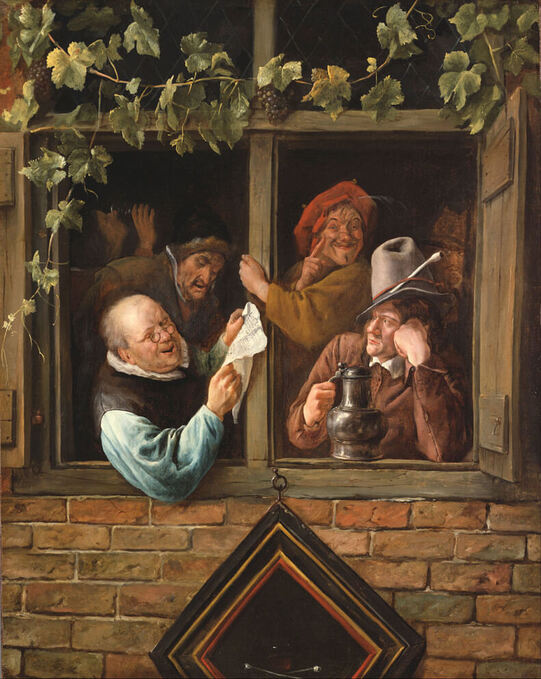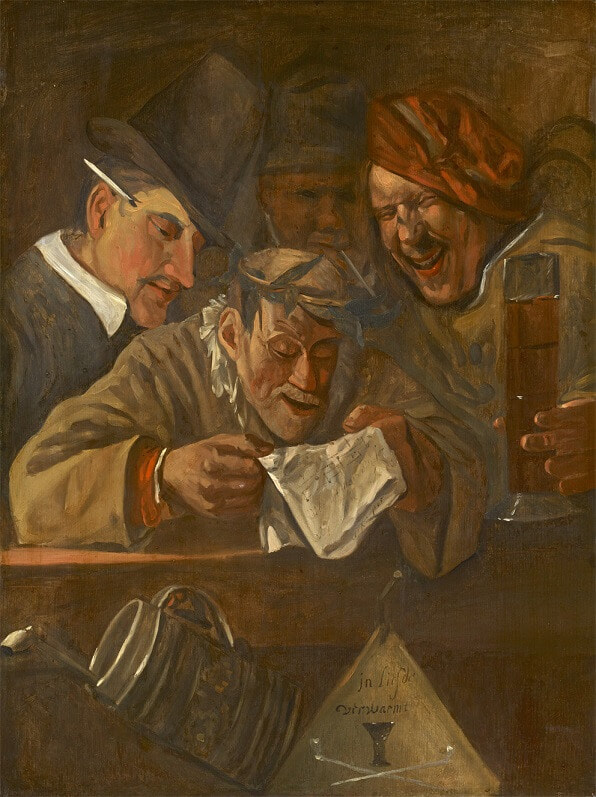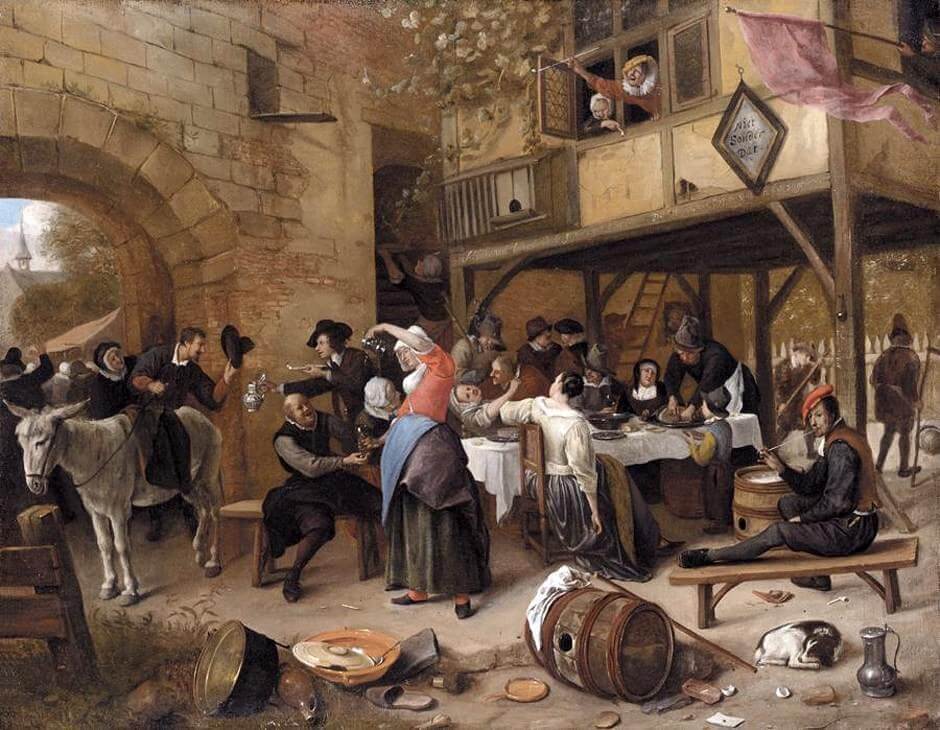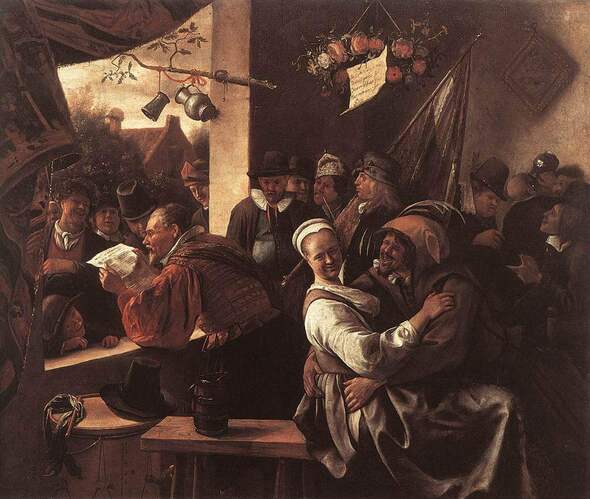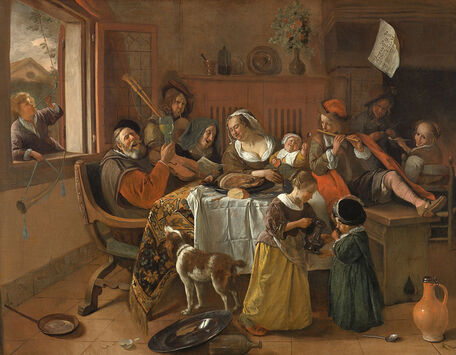|
Where? Gallery 264 of the Philadelphia Museum of Art
When? 1658-1665 What do you see? A window with at least five men who seem to be enjoying themselves (it seems that there is a sixth man on the top right, but he is not clearly visible). These men are members of the chamber of rhetoric, which is a society of amateur poets and performers, and these societies existed in Belgium and The Netherlands since the 15th century. On the left, a man is enthusiastically singing from a paper entitled ‘lof liet’, which is Dutch for ‘song of praise’. The person standing behind him has created this song. Behind them stands a man who is drinking. The person sitting in the right window is critically listening to the song. He is firmly holding a jug that probably contains wine. He is wearing a hat with a pipe attached to it. Behind him is a so-called jester wearing a red cap. He is entertaining the crowd (which you cannot see, but who are also listening to this performance) and puts up his finger to capture their attention. On top of the window grows a vine with ripe grapes. Below the window hangs the emblem of this chamber of rhetoricians, which includes a glass of wine and two crossed pipes. Backstory: Jan Steen painted the rhetoricians more often during his career. In this painting, it is unclear whether Steen wanted to show his appreciation for the rhetoricians or whether he is somewhat sarcastic in the way he depicts them due to the many references to drinking. Steen created several other paintings featuring the rhetoricians. The painting Rhetoricians of Steen is currently in Museum Bredius in The Hague. The Feast of the Chamber of Rhetoricians near a Town-Gate is in a private collection. The Rhetoricians - In Liefde Vrij is in the Royal Museums of Fine Arts of Belgium in Brussels.
Symbolism: The people in this painting show different emotions. Some believe that this painting expresses the four temperaments:
Chamber of rhetoricians: This society was a popular one in Belgium and The Netherlands since the 15th century. They existed both in large cities and small towns and focused on poetry and drama. They were often depicted, by artists like Jan Steen, as people that primarily liked to drink large quantities of wine. However, in reality, these societies were a little bit more serious and also provided cultural experiences for the common people by organizing plays and poetry contests. Their performances focused on providing morals to the people and stimulating the audience intellectually. However, as indicated by the emblem in this painting, the chamber was also a social place where members drank wine and engaged in discussions. Who is Steen? Jan Havickszoon Steen was born in Leiden, The Netherlands, in 1626, and also died there in 1679. He lived at the same time as Rembrandt. Steen came from a family of brewers, which may explain the abundance of alcohol in some of his paintings (which also includes alcohol consumption by children, like in his painting The Merry Family in the Rijksmuseum). He is also known to drink quite a bit himself. Steen is considered a genre painter as he often depicted scenes from everyday life. However, he has also created some paintings with biblical, mythological, and historical themes. He often incorporated some humor in his paintings, is known for his colorful paintings, and his contemporaries appreciated his works. Steen created many paintings during his life, and over 300 of them have survived.
Fun fact: In the 17th century, people consumed a lot of alcohol as the water quality was poor and alcoholic beverages were much safer to drink. Alcohol was even served in both the Catholic and Protestant church. Drinking was an important part of the many guilds and societies in the Dutch Republic during this time. Festivals were organized by all the guilds and societies, and usually, the emphasis of these festivals was on excessive drinking and eating.
It seems that the members of the chamber of rhetoricians drank more than average and drinking was an important part of their meetings. Drinking was also one of the more common themes of their poems and plays, and when they performed for an audience, drinks were always nearby.
Written by Eelco Kappe
References:
0 Comments
Leave a Reply. |
Categories
All
|
- Home
- Blog
-
Museums
- Alte Pinakothek
- Art Institute of Chicago
- Baltimore Museum of Art
- Barber Institute of Fine Arts
- Bargello
- Barnes Foundation
- British Museum
- Church of Sant’Anastasia
- Cleveland Museum of Art
- Courtauld Institute of Art
- Detroit Institute of Arts
- Frans Hals Museum
- Galleria Borghese
- Gallerie dell'Accademia
- Getty Museum
- Guggenheim
- Hermitage Museum
- Kunsthistorisches Museum
- Kunstmuseum Basel
- Legion of Honor Museum
- Louvre
- Mauritshuis
- Metropolitan Museum of Art
- Musee d’Orsay
- Museum of Fine Arts in Boston
- Museum of Modern Art
- National Gallery in London
- National Gallery of Art
- National Museum in Poznań
- Norton Simon Museum
- Ny Carlsberg Glyptotek
- Palace of Versailles
- Palazzo Pitti
- Palazzo Vecchio
- Petit Palais
- Philadelphia Museum of Art
- Prado
- Pushkin Museum
- Ravenna Art Museum
- Rijksmuseum
- San Diego Museum of Art
- Santa Maria delle Grazie
- St. Peter's Basilica
- Städel Museum
- Statens Museum for Kunst
- Tate Britain
- Tate Modern
- Timken Museum of Art
- Uffizi
- Vatican Museums
- Wallace Collection
-
Artists
- Altdorfer
- Anguissola
- Berlin Painter
- Bosch
- Botticelli
- Boucher
- Bronzino
- Bruegel the Elder
- Brunelleschi
- Cabanel
- Caillebotte
- Canova
- Caravaggio
- Carpeaux
- Cezanne
- Cimabue
- David
- Degas
- Delacroix
- De Maria
- Donatello
- El Greco
- Fontana
- Fra Angelico
- Fragonard
- Gauguin
- Gentileschi
- Gericault
- Gonzalez-Torres
- Goya
- Hals
- Hogarth
- Hokusai
- Ingres
- Leonardo da Vinci
- Lippi, Filippo
- Longhi, Barbara
- Lorrain
- Makovsky
- Manet
- Massys
- Matisse
- Merian
- Michelangelo
- Mochi
- Modigliani
- Monet
- Panini
- Parmigianino
- Perugino
- Picasso
- Pisanello
- Raphael
- Rembrandt
- Renoir
- Reynolds
- Rivera
- Rodin
- Rubens
- Scultori
- Seurat
- Steen
- Tintoretto
- Titian
- Toulouse-Lautrec
- Turner
- Uccello
- Van der Weyden
- Van Dyck
- Van Eyck
- Van Gogh
- Van Hemessen
- Vasari
- Velazquez
- Vermeer
- Veronese
- Vigée Le Brun
-
Locations
- Books
- About Us

